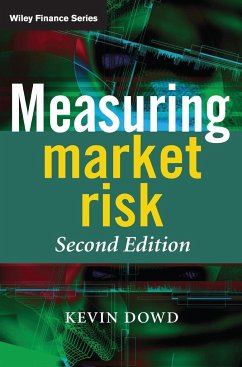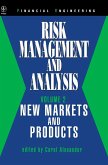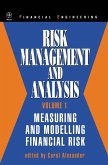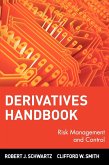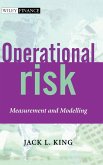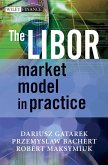Kevin Dowd
Measuring Market Risk
Kevin Dowd
Measuring Market Risk
- Gebundenes Buch
- Merkliste
- Auf die Merkliste
- Bewerten Bewerten
- Teilen
- Produkt teilen
- Produkterinnerung
- Produkterinnerung
Fully revised and restructured, Measuring Market Risk, Second Edition includes a new chapter on options risk management, as well as substantial new information on parametric risk, non parametric measurements and liquidity risks, more practical information to help with specific calculations, and new examples including Q&A s and case studies.
Andere Kunden interessierten sich auch für
![Risk Management and Analysis, Volume 2 Risk Management and Analysis, Volume 2]() Carol Alexander (Hrsg.)Risk Management and Analysis, Volume 2172,99 €
Carol Alexander (Hrsg.)Risk Management and Analysis, Volume 2172,99 €![Risk Management and Analysis, Volume 1 Risk Management and Analysis, Volume 1]() Carol Alexander (Hrsg.)Risk Management and Analysis, Volume 1172,99 €
Carol Alexander (Hrsg.)Risk Management and Analysis, Volume 1172,99 €![Derivatives Handbook Derivatives Handbook]() Robert J. Schwartz / Clifford W. Smith (Hgg.)Derivatives Handbook78,99 €
Robert J. Schwartz / Clifford W. Smith (Hgg.)Derivatives Handbook78,99 €![Operational Risk Operational Risk]() Jack L. KingOperational Risk174,99 €
Jack L. KingOperational Risk174,99 €![The LIBOR Market Model in Practice The LIBOR Market Model in Practice]() Dariusz GatarekThe LIBOR Market Model in Practice140,99 €
Dariusz GatarekThe LIBOR Market Model in Practice140,99 €![Risk and Financial Management Risk and Financial Management]() Charles TapieroRisk and Financial Management151,99 €
Charles TapieroRisk and Financial Management151,99 €![The Best of Wilmott 1 The Best of Wilmott 1]() The Best of Wilmott 1169,99 €
The Best of Wilmott 1169,99 €-
-
-
Fully revised and restructured, Measuring Market Risk, Second Edition includes a new chapter on options risk management, as well as substantial new information on parametric risk, non parametric measurements and liquidity risks, more practical information to help with specific calculations, and new examples including Q&A s and case studies.
Hinweis: Dieser Artikel kann nur an eine deutsche Lieferadresse ausgeliefert werden.
Hinweis: Dieser Artikel kann nur an eine deutsche Lieferadresse ausgeliefert werden.
Produktdetails
- Produktdetails
- Verlag: Wiley & Sons
- 2. Aufl.
- Seitenzahl: 416
- Erscheinungstermin: 1. Juli 2005
- Englisch
- Abmessung: 250mm x 175mm x 27mm
- Gewicht: 955g
- ISBN-13: 9780470013038
- ISBN-10: 0470013036
- Artikelnr.: 14719530
- Herstellerkennzeichnung
- Libri GmbH
- Europaallee 1
- 36244 Bad Hersfeld
- gpsr@libri.de
- Verlag: Wiley & Sons
- 2. Aufl.
- Seitenzahl: 416
- Erscheinungstermin: 1. Juli 2005
- Englisch
- Abmessung: 250mm x 175mm x 27mm
- Gewicht: 955g
- ISBN-13: 9780470013038
- ISBN-10: 0470013036
- Artikelnr.: 14719530
- Herstellerkennzeichnung
- Libri GmbH
- Europaallee 1
- 36244 Bad Hersfeld
- gpsr@libri.de
Kevin Dowd is Professor of Financial Risk Management at Nottingham University. Kevin is an Adjunct Scholar at the Cato Institute in Washington, D.C., and a Fellow of the Pensions Institute at Birkbeck College.
Preface to the Second Edition xiii
Acknowledgements xix
1 The Rise of Value at Risk 1
1.1 The emergence of financial risk management 2
1.2 Market risk measurement 4
1.3 Risk measurement before VaR 5
1.3.1 Gap analysis 5
1.3.2 Duration analysis 5
1.3.3 Scenario analysis 6
1.3.4 Portfolio theory 7
1.3.5 Derivatives risk measures 8
1.4 Value at risk 9
1.4.1 The origin and development of VaR 9
1.4.2 Attractions of VaR 11
1.4.3 Criticisms of VaR 13
Appendix: Types of Market Risk 15
2 Measures of Financial Risk 19
2.1 The mean-variance framework for measuring financial risk 20
2.2 Value at risk 27
2.2.1 Basics of VaR 27
2.2.2 Determination of the VaR parameters 29
2.2.3 Limitations of VaR as a risk measure 31
2.3 Coherent risk measures 32
2.3.1 The coherence axioms and their implications 32
2.3.2 The expected shortfall 35
2.3.3 Spectral risk measures 37
2.3.4 Scenarios as coherent risk measures 42
2.4 Conclusions 44
Appendix 1: Probability Functions 45
Appendix 2: Regulatory Uses of VaR 52
3 Estimating Market Risk Measures: An Introduction and Overview 53
3.1 Data 53
3.1.1 Profit/loss data 53
3.1.2 Loss/profit data 54
3.1.3 Arithmetic return data 54
3.1.4 Geometric return data 54
3.2 Estimating historical simulation VaR 56
3.3 Estimating parametric VaR 57
3.3.1 Estimating VaR with normally distributed profits/losses 57
3.3.2 Estimating VaR with normally distributed arithmetic returns 59
3.3.3 Estimating lognormal VaR 61
3.4 Estimating coherent risk measures 64
3.4.1 Estimating expected shortfall 64
3.4.2 Estimating coherent risk measures 64
3.5 Estimating the standard errors of risk measure estimators 69
3.5.1 Standard errors of quantile estimators 69
3.5.2 Standard errors in estimators of coherent risk measures 72
3.6 The core issues: an overview 73
Appendix 1: Preliminary Data Analysis 75
Appendix 2: Numerical Integration Methods 80
4 Non-parametric Approaches 83
4.1 Compiling historical simulation data 84
4.2 Estimation of historical simulation VaR and ES 84
4.2.1 Basic historical simulation 84
4.2.2 Bootstrapped historical simulation 85
4.2.3 Historical simulation using non-parametric density estimation 86
4.2.4 Estimating curves and surfaces for VAR and ES 88
4.3 Estimating confidence intervals for historical simulation VaR and ES 89
4.3.1 An order-statistics approach to the estimation of confidence
intervals for HS VaR and ES 89
4.3.2 A bootstrap approach to the estimation of confidence intervals for HS
VaR and ES 90
4.4 Weighted historical simulation 92
4.4.1 Age-weighted historical simulation 93
4.4.2 Volatility-weighted historical simulation 94
4.4.3 Correlation-weighted historical simulation 95
4.4.4 Filtered historical simulation 96
4.5 Advantages and disadvantages of non-parametric methods 99
4.5.1 Advantages 99
4.5.2 Disadvantages 100
4.6 Conclusions 101
Appendix 1: Estimating Risk Measures with Order Statistics 102
Appendix 2: The Bootstrap 105
Appendix 3: Non-parametric Density Estimation 111
Appendix 4: Principal Components Analysis and Factor Analysis 118
5 Forecasting Volatilities, Covariances and Correlations 127
5.1 Forecasting volatilities 127
5.1.1 Defining volatility 127
5.1.2 Historical volatility forecasts 128
5.1.3 Exponentially weighted moving average volatility 129
5.1.4 GARCH models 131
5.1.5 Implied volatilities 136
5.2 Forecasting covariances and correlations 137
5.2.1 Defining covariances and correlations 137
5.2.2 Historical covariances and correlations 138
5.2.3 Exponentially weighted moving average covariances 140
5.2.4 GARCH covariances 140
5.2.5 Implied covariances and correlations 141
5.2.6 Some pitfalls with correlation estimation 141
5.3 Forecasting covariance matrices 142
5.3.1 Positive definiteness and positive semi-definiteness 142
5.3.2 Historical variance-covariance estimation 142
5.3.3 Multivariate EWMA 142
5.3.4 Multivariate GARCH 142
5.3.5 Computational problems with covariance and correlation matrices 143
Appendix: Modelling Dependence: Correlations and Copulas 145
6 Parametric Approaches (I) 151
6.1 Conditional vs unconditional distributions 152
6.2 Normal VaR and ES 154
6.3 The t-distribution 159
6.4 The lognormal distribution 161
6.5 Miscellaneous parametric approaches 165
6.5.1 Lévy approaches 165
6.5.2 Elliptical and hyperbolic approaches 167
6.5.3 Normal mixture approaches 167
6.5.4 Jump diffusion 168
6.5.5 Stochastic volatility approaches 169
6.5.6 The Cornish-Fisher approximation 171
6.6 The multivariate normal variance-covariance approach 173
6.7 Non-normal variance-covariance approaches 176
6.7.1 Multivariate t-distributions 176
6.7.2 Multivariate elliptical distributions 177
6.7.3 The Hull-White transformation-into-normality approach 177
6.8 Handling multivariate return distributions with copulas 178
6.8.1 Motivation 178
6.8.2 Estimating VaR with copulas 179
6.9 Conclusions 182
Appendix: Forecasting Longer-term Risk Measures 184
7 Parametric Approaches (II): Extreme Value 189
7.1 Generalised extreme-value theory 190
7.1.1 Theory 190
7.1.2 A short-cut EV method 194
7.1.3 Estimation of EV parameters 195
7.2 The peaks-over-threshold approach: the generalised Pareto distribution
201
7.2.1 Theory 201
7.2.2 Estimation 203
7.2.3 GEV vs POT 204
7.3 Refinements to EV approaches 204
7.3.1 Conditional EV 204
7.3.2 Dealing with dependent (or non-iid) data 205
7.3.3 Multivariate EVT 206
7.4 Conclusions 206
8 Monte Carlo Simulation Methods 209
8.1 Uses of Monte carlo simulation 210
8.2 Monte Carlo simulation with a single risk factor 213
8.3 Monte Carlo simulation with multiple risk factors 215
8.4 Variance-reduction methods 217
8.4.1 Antithetic variables 218
8.4.2 Control variates 218
8.4.3 Importance sampling 219
8.4.4 Stratified sampling 220
8.4.5 Moment matching 223
8.5 Advantages and disadvantages of Monte Carlo simulation 225
8.5.1 Advantages 225
8.5.2 Disadvantages 225
8.6 Conclusions 225
9 Applications of Stochastic Risk Measurement Methods 227
9.1 Selecting stochastic processes 227
9.2 Dealing with multivariate stochastic processes 230
9.2.1 Principal components simulation 230
9.2.2 Scenario simulation 232
9.3 Dynamic risks 234
9.4 Fixed-income risks 236
9.4.1 Distinctive features of fixed-income problems 237
9.4.2 Estimating fixed-income risk measures 237
9.5 Credit-related risks 238
9.6 Insurance risks 240
9.6.1 General insurance risks 241
9.6.2 Life insurance risks 242
9.7 Measuring pensions risks 244
9.7.1 Estimating risks of defined-benefit pension plans 245
9.7.2 Estimating risks of defined-contribution pension plans 246
9.8 Conclusions 248
10 Estimating Options Risk Measures 249
10.1 Analytical and algorithmic solutions for options VaR 249
10.2 Simulation approaches 253
10.3 Delta-gamma and related approaches 256
10.3.1 Delta-normal approaches 257
10.3.2 Delta-gamma approaches 258
10.4 Conclusions 264
11 Incremental and Component Risks 265
11.1 Incremental VaR 265
11.1.1 Interpreting Incremental VaR 265
11.1.2 Estimating IVaR by brute force: the 'before and after' approach 266
11.1.3 Estimating IVaR using analytical solutions 267
11.2 Component VaR 271
11.2.1 Properties of component VaR 271
11.2.2 Uses of component VaR 274
11.3 Decomposition of coherent risk measures 277
12 Mapping Positions to Risk Factors 279
12.1 Selecting core instruments 280
12.2 Mapping positions and VaR estimation 281
12.2.1 Basic building blocks 281
12.2.2 More complex positions 287
13 Stress Testing 291
13.1 Benefits and difficulties of stress testing 293
13.1.1 Benefits of stress testing 293
13.1.2 Difficulties with stress tests 295
13.2 Scenario analysis 297
13.2.1 Choosing scenarios 297
13.2.2 Evaluating the effects of scenarios 300
13.3 Mechanical stress testing 303
13.3.1 Factor push analysis 303
13.3.2 Maximum loss optimisation 305
13.3.3 CrashMetrics 305
13.4 Conclusions 306
14 Estimating Liquidity Risks 309
14.1 Liquidity and liquidity risks 309
14.2 Estimating liquidity-adjusted VaR 310
14.2.1 The constant spread approach 311
14.2.2 The exogenous spread approach 312
14.2.3 Endogenous-price approaches 314
14.2.4 The liquidity discount approach 315
14.3 Estimating liquidity at risk (LaR) 316
14.4 Estimating liquidity in crises 319
15 Backtesting Market Risk Models 321
15.1 Preliminary data issues 321
15.2 Backtests based on frequency tests 323
15.2.1 The basic frequency backtest 324
15.2.2 The conditional testing (Christoffersen) backtest 329
15.3 Backtests based on tests of distribution equality 331
15.3.1 Tests based on the Rosenblatt transformation 331
15.3.2 Tests using the Berkowitz transformation 333
15.3.3 Overlapping forecast periods 335
15.4 Comparing alternative models 336
15.5 Backtesting with alternative positions and data 339
15.5.1 Backtesting with alternative positions 340
15.5.2 Backtesting with alternative data 340
15.6 Assessing the precision of backtest results 340
15.7 Summary and conclusions 342
Appendix: Testing Whether Two Distributions are Different 343
16 Model Risk 351
16.1 Models and model risk 351
16.2 Sources of model risk 353
16.2.1 Incorrect model specification 353
16.2.2 Incorrect model application 354
16.2.3 Implementation risk 354
16.2.4 Other sources of model risk 355
16.3 Quantifying model risk 357
16.4 Managing model risk 359
16.4.1 Managing model risk: some guidelines for risk practitioners 359
16.4.2 Managing model risk: some guidelines for senior managers 360
16.4.3 Institutional methods to manage model risk 361
16.5 Conclusions 363
Bibliography 365
Index 379
Acknowledgements xix
1 The Rise of Value at Risk 1
1.1 The emergence of financial risk management 2
1.2 Market risk measurement 4
1.3 Risk measurement before VaR 5
1.3.1 Gap analysis 5
1.3.2 Duration analysis 5
1.3.3 Scenario analysis 6
1.3.4 Portfolio theory 7
1.3.5 Derivatives risk measures 8
1.4 Value at risk 9
1.4.1 The origin and development of VaR 9
1.4.2 Attractions of VaR 11
1.4.3 Criticisms of VaR 13
Appendix: Types of Market Risk 15
2 Measures of Financial Risk 19
2.1 The mean-variance framework for measuring financial risk 20
2.2 Value at risk 27
2.2.1 Basics of VaR 27
2.2.2 Determination of the VaR parameters 29
2.2.3 Limitations of VaR as a risk measure 31
2.3 Coherent risk measures 32
2.3.1 The coherence axioms and their implications 32
2.3.2 The expected shortfall 35
2.3.3 Spectral risk measures 37
2.3.4 Scenarios as coherent risk measures 42
2.4 Conclusions 44
Appendix 1: Probability Functions 45
Appendix 2: Regulatory Uses of VaR 52
3 Estimating Market Risk Measures: An Introduction and Overview 53
3.1 Data 53
3.1.1 Profit/loss data 53
3.1.2 Loss/profit data 54
3.1.3 Arithmetic return data 54
3.1.4 Geometric return data 54
3.2 Estimating historical simulation VaR 56
3.3 Estimating parametric VaR 57
3.3.1 Estimating VaR with normally distributed profits/losses 57
3.3.2 Estimating VaR with normally distributed arithmetic returns 59
3.3.3 Estimating lognormal VaR 61
3.4 Estimating coherent risk measures 64
3.4.1 Estimating expected shortfall 64
3.4.2 Estimating coherent risk measures 64
3.5 Estimating the standard errors of risk measure estimators 69
3.5.1 Standard errors of quantile estimators 69
3.5.2 Standard errors in estimators of coherent risk measures 72
3.6 The core issues: an overview 73
Appendix 1: Preliminary Data Analysis 75
Appendix 2: Numerical Integration Methods 80
4 Non-parametric Approaches 83
4.1 Compiling historical simulation data 84
4.2 Estimation of historical simulation VaR and ES 84
4.2.1 Basic historical simulation 84
4.2.2 Bootstrapped historical simulation 85
4.2.3 Historical simulation using non-parametric density estimation 86
4.2.4 Estimating curves and surfaces for VAR and ES 88
4.3 Estimating confidence intervals for historical simulation VaR and ES 89
4.3.1 An order-statistics approach to the estimation of confidence
intervals for HS VaR and ES 89
4.3.2 A bootstrap approach to the estimation of confidence intervals for HS
VaR and ES 90
4.4 Weighted historical simulation 92
4.4.1 Age-weighted historical simulation 93
4.4.2 Volatility-weighted historical simulation 94
4.4.3 Correlation-weighted historical simulation 95
4.4.4 Filtered historical simulation 96
4.5 Advantages and disadvantages of non-parametric methods 99
4.5.1 Advantages 99
4.5.2 Disadvantages 100
4.6 Conclusions 101
Appendix 1: Estimating Risk Measures with Order Statistics 102
Appendix 2: The Bootstrap 105
Appendix 3: Non-parametric Density Estimation 111
Appendix 4: Principal Components Analysis and Factor Analysis 118
5 Forecasting Volatilities, Covariances and Correlations 127
5.1 Forecasting volatilities 127
5.1.1 Defining volatility 127
5.1.2 Historical volatility forecasts 128
5.1.3 Exponentially weighted moving average volatility 129
5.1.4 GARCH models 131
5.1.5 Implied volatilities 136
5.2 Forecasting covariances and correlations 137
5.2.1 Defining covariances and correlations 137
5.2.2 Historical covariances and correlations 138
5.2.3 Exponentially weighted moving average covariances 140
5.2.4 GARCH covariances 140
5.2.5 Implied covariances and correlations 141
5.2.6 Some pitfalls with correlation estimation 141
5.3 Forecasting covariance matrices 142
5.3.1 Positive definiteness and positive semi-definiteness 142
5.3.2 Historical variance-covariance estimation 142
5.3.3 Multivariate EWMA 142
5.3.4 Multivariate GARCH 142
5.3.5 Computational problems with covariance and correlation matrices 143
Appendix: Modelling Dependence: Correlations and Copulas 145
6 Parametric Approaches (I) 151
6.1 Conditional vs unconditional distributions 152
6.2 Normal VaR and ES 154
6.3 The t-distribution 159
6.4 The lognormal distribution 161
6.5 Miscellaneous parametric approaches 165
6.5.1 Lévy approaches 165
6.5.2 Elliptical and hyperbolic approaches 167
6.5.3 Normal mixture approaches 167
6.5.4 Jump diffusion 168
6.5.5 Stochastic volatility approaches 169
6.5.6 The Cornish-Fisher approximation 171
6.6 The multivariate normal variance-covariance approach 173
6.7 Non-normal variance-covariance approaches 176
6.7.1 Multivariate t-distributions 176
6.7.2 Multivariate elliptical distributions 177
6.7.3 The Hull-White transformation-into-normality approach 177
6.8 Handling multivariate return distributions with copulas 178
6.8.1 Motivation 178
6.8.2 Estimating VaR with copulas 179
6.9 Conclusions 182
Appendix: Forecasting Longer-term Risk Measures 184
7 Parametric Approaches (II): Extreme Value 189
7.1 Generalised extreme-value theory 190
7.1.1 Theory 190
7.1.2 A short-cut EV method 194
7.1.3 Estimation of EV parameters 195
7.2 The peaks-over-threshold approach: the generalised Pareto distribution
201
7.2.1 Theory 201
7.2.2 Estimation 203
7.2.3 GEV vs POT 204
7.3 Refinements to EV approaches 204
7.3.1 Conditional EV 204
7.3.2 Dealing with dependent (or non-iid) data 205
7.3.3 Multivariate EVT 206
7.4 Conclusions 206
8 Monte Carlo Simulation Methods 209
8.1 Uses of Monte carlo simulation 210
8.2 Monte Carlo simulation with a single risk factor 213
8.3 Monte Carlo simulation with multiple risk factors 215
8.4 Variance-reduction methods 217
8.4.1 Antithetic variables 218
8.4.2 Control variates 218
8.4.3 Importance sampling 219
8.4.4 Stratified sampling 220
8.4.5 Moment matching 223
8.5 Advantages and disadvantages of Monte Carlo simulation 225
8.5.1 Advantages 225
8.5.2 Disadvantages 225
8.6 Conclusions 225
9 Applications of Stochastic Risk Measurement Methods 227
9.1 Selecting stochastic processes 227
9.2 Dealing with multivariate stochastic processes 230
9.2.1 Principal components simulation 230
9.2.2 Scenario simulation 232
9.3 Dynamic risks 234
9.4 Fixed-income risks 236
9.4.1 Distinctive features of fixed-income problems 237
9.4.2 Estimating fixed-income risk measures 237
9.5 Credit-related risks 238
9.6 Insurance risks 240
9.6.1 General insurance risks 241
9.6.2 Life insurance risks 242
9.7 Measuring pensions risks 244
9.7.1 Estimating risks of defined-benefit pension plans 245
9.7.2 Estimating risks of defined-contribution pension plans 246
9.8 Conclusions 248
10 Estimating Options Risk Measures 249
10.1 Analytical and algorithmic solutions for options VaR 249
10.2 Simulation approaches 253
10.3 Delta-gamma and related approaches 256
10.3.1 Delta-normal approaches 257
10.3.2 Delta-gamma approaches 258
10.4 Conclusions 264
11 Incremental and Component Risks 265
11.1 Incremental VaR 265
11.1.1 Interpreting Incremental VaR 265
11.1.2 Estimating IVaR by brute force: the 'before and after' approach 266
11.1.3 Estimating IVaR using analytical solutions 267
11.2 Component VaR 271
11.2.1 Properties of component VaR 271
11.2.2 Uses of component VaR 274
11.3 Decomposition of coherent risk measures 277
12 Mapping Positions to Risk Factors 279
12.1 Selecting core instruments 280
12.2 Mapping positions and VaR estimation 281
12.2.1 Basic building blocks 281
12.2.2 More complex positions 287
13 Stress Testing 291
13.1 Benefits and difficulties of stress testing 293
13.1.1 Benefits of stress testing 293
13.1.2 Difficulties with stress tests 295
13.2 Scenario analysis 297
13.2.1 Choosing scenarios 297
13.2.2 Evaluating the effects of scenarios 300
13.3 Mechanical stress testing 303
13.3.1 Factor push analysis 303
13.3.2 Maximum loss optimisation 305
13.3.3 CrashMetrics 305
13.4 Conclusions 306
14 Estimating Liquidity Risks 309
14.1 Liquidity and liquidity risks 309
14.2 Estimating liquidity-adjusted VaR 310
14.2.1 The constant spread approach 311
14.2.2 The exogenous spread approach 312
14.2.3 Endogenous-price approaches 314
14.2.4 The liquidity discount approach 315
14.3 Estimating liquidity at risk (LaR) 316
14.4 Estimating liquidity in crises 319
15 Backtesting Market Risk Models 321
15.1 Preliminary data issues 321
15.2 Backtests based on frequency tests 323
15.2.1 The basic frequency backtest 324
15.2.2 The conditional testing (Christoffersen) backtest 329
15.3 Backtests based on tests of distribution equality 331
15.3.1 Tests based on the Rosenblatt transformation 331
15.3.2 Tests using the Berkowitz transformation 333
15.3.3 Overlapping forecast periods 335
15.4 Comparing alternative models 336
15.5 Backtesting with alternative positions and data 339
15.5.1 Backtesting with alternative positions 340
15.5.2 Backtesting with alternative data 340
15.6 Assessing the precision of backtest results 340
15.7 Summary and conclusions 342
Appendix: Testing Whether Two Distributions are Different 343
16 Model Risk 351
16.1 Models and model risk 351
16.2 Sources of model risk 353
16.2.1 Incorrect model specification 353
16.2.2 Incorrect model application 354
16.2.3 Implementation risk 354
16.2.4 Other sources of model risk 355
16.3 Quantifying model risk 357
16.4 Managing model risk 359
16.4.1 Managing model risk: some guidelines for risk practitioners 359
16.4.2 Managing model risk: some guidelines for senior managers 360
16.4.3 Institutional methods to manage model risk 361
16.5 Conclusions 363
Bibliography 365
Index 379
Preface to the Second Edition xiii
Acknowledgements xix
1 The Rise of Value at Risk 1
1.1 The emergence of financial risk management 2
1.2 Market risk measurement 4
1.3 Risk measurement before VaR 5
1.3.1 Gap analysis 5
1.3.2 Duration analysis 5
1.3.3 Scenario analysis 6
1.3.4 Portfolio theory 7
1.3.5 Derivatives risk measures 8
1.4 Value at risk 9
1.4.1 The origin and development of VaR 9
1.4.2 Attractions of VaR 11
1.4.3 Criticisms of VaR 13
Appendix: Types of Market Risk 15
2 Measures of Financial Risk 19
2.1 The mean-variance framework for measuring financial risk 20
2.2 Value at risk 27
2.2.1 Basics of VaR 27
2.2.2 Determination of the VaR parameters 29
2.2.3 Limitations of VaR as a risk measure 31
2.3 Coherent risk measures 32
2.3.1 The coherence axioms and their implications 32
2.3.2 The expected shortfall 35
2.3.3 Spectral risk measures 37
2.3.4 Scenarios as coherent risk measures 42
2.4 Conclusions 44
Appendix 1: Probability Functions 45
Appendix 2: Regulatory Uses of VaR 52
3 Estimating Market Risk Measures: An Introduction and Overview 53
3.1 Data 53
3.1.1 Profit/loss data 53
3.1.2 Loss/profit data 54
3.1.3 Arithmetic return data 54
3.1.4 Geometric return data 54
3.2 Estimating historical simulation VaR 56
3.3 Estimating parametric VaR 57
3.3.1 Estimating VaR with normally distributed profits/losses 57
3.3.2 Estimating VaR with normally distributed arithmetic returns 59
3.3.3 Estimating lognormal VaR 61
3.4 Estimating coherent risk measures 64
3.4.1 Estimating expected shortfall 64
3.4.2 Estimating coherent risk measures 64
3.5 Estimating the standard errors of risk measure estimators 69
3.5.1 Standard errors of quantile estimators 69
3.5.2 Standard errors in estimators of coherent risk measures 72
3.6 The core issues: an overview 73
Appendix 1: Preliminary Data Analysis 75
Appendix 2: Numerical Integration Methods 80
4 Non-parametric Approaches 83
4.1 Compiling historical simulation data 84
4.2 Estimation of historical simulation VaR and ES 84
4.2.1 Basic historical simulation 84
4.2.2 Bootstrapped historical simulation 85
4.2.3 Historical simulation using non-parametric density estimation 86
4.2.4 Estimating curves and surfaces for VAR and ES 88
4.3 Estimating confidence intervals for historical simulation VaR and ES 89
4.3.1 An order-statistics approach to the estimation of confidence
intervals for HS VaR and ES 89
4.3.2 A bootstrap approach to the estimation of confidence intervals for HS
VaR and ES 90
4.4 Weighted historical simulation 92
4.4.1 Age-weighted historical simulation 93
4.4.2 Volatility-weighted historical simulation 94
4.4.3 Correlation-weighted historical simulation 95
4.4.4 Filtered historical simulation 96
4.5 Advantages and disadvantages of non-parametric methods 99
4.5.1 Advantages 99
4.5.2 Disadvantages 100
4.6 Conclusions 101
Appendix 1: Estimating Risk Measures with Order Statistics 102
Appendix 2: The Bootstrap 105
Appendix 3: Non-parametric Density Estimation 111
Appendix 4: Principal Components Analysis and Factor Analysis 118
5 Forecasting Volatilities, Covariances and Correlations 127
5.1 Forecasting volatilities 127
5.1.1 Defining volatility 127
5.1.2 Historical volatility forecasts 128
5.1.3 Exponentially weighted moving average volatility 129
5.1.4 GARCH models 131
5.1.5 Implied volatilities 136
5.2 Forecasting covariances and correlations 137
5.2.1 Defining covariances and correlations 137
5.2.2 Historical covariances and correlations 138
5.2.3 Exponentially weighted moving average covariances 140
5.2.4 GARCH covariances 140
5.2.5 Implied covariances and correlations 141
5.2.6 Some pitfalls with correlation estimation 141
5.3 Forecasting covariance matrices 142
5.3.1 Positive definiteness and positive semi-definiteness 142
5.3.2 Historical variance-covariance estimation 142
5.3.3 Multivariate EWMA 142
5.3.4 Multivariate GARCH 142
5.3.5 Computational problems with covariance and correlation matrices 143
Appendix: Modelling Dependence: Correlations and Copulas 145
6 Parametric Approaches (I) 151
6.1 Conditional vs unconditional distributions 152
6.2 Normal VaR and ES 154
6.3 The t-distribution 159
6.4 The lognormal distribution 161
6.5 Miscellaneous parametric approaches 165
6.5.1 Lévy approaches 165
6.5.2 Elliptical and hyperbolic approaches 167
6.5.3 Normal mixture approaches 167
6.5.4 Jump diffusion 168
6.5.5 Stochastic volatility approaches 169
6.5.6 The Cornish-Fisher approximation 171
6.6 The multivariate normal variance-covariance approach 173
6.7 Non-normal variance-covariance approaches 176
6.7.1 Multivariate t-distributions 176
6.7.2 Multivariate elliptical distributions 177
6.7.3 The Hull-White transformation-into-normality approach 177
6.8 Handling multivariate return distributions with copulas 178
6.8.1 Motivation 178
6.8.2 Estimating VaR with copulas 179
6.9 Conclusions 182
Appendix: Forecasting Longer-term Risk Measures 184
7 Parametric Approaches (II): Extreme Value 189
7.1 Generalised extreme-value theory 190
7.1.1 Theory 190
7.1.2 A short-cut EV method 194
7.1.3 Estimation of EV parameters 195
7.2 The peaks-over-threshold approach: the generalised Pareto distribution
201
7.2.1 Theory 201
7.2.2 Estimation 203
7.2.3 GEV vs POT 204
7.3 Refinements to EV approaches 204
7.3.1 Conditional EV 204
7.3.2 Dealing with dependent (or non-iid) data 205
7.3.3 Multivariate EVT 206
7.4 Conclusions 206
8 Monte Carlo Simulation Methods 209
8.1 Uses of Monte carlo simulation 210
8.2 Monte Carlo simulation with a single risk factor 213
8.3 Monte Carlo simulation with multiple risk factors 215
8.4 Variance-reduction methods 217
8.4.1 Antithetic variables 218
8.4.2 Control variates 218
8.4.3 Importance sampling 219
8.4.4 Stratified sampling 220
8.4.5 Moment matching 223
8.5 Advantages and disadvantages of Monte Carlo simulation 225
8.5.1 Advantages 225
8.5.2 Disadvantages 225
8.6 Conclusions 225
9 Applications of Stochastic Risk Measurement Methods 227
9.1 Selecting stochastic processes 227
9.2 Dealing with multivariate stochastic processes 230
9.2.1 Principal components simulation 230
9.2.2 Scenario simulation 232
9.3 Dynamic risks 234
9.4 Fixed-income risks 236
9.4.1 Distinctive features of fixed-income problems 237
9.4.2 Estimating fixed-income risk measures 237
9.5 Credit-related risks 238
9.6 Insurance risks 240
9.6.1 General insurance risks 241
9.6.2 Life insurance risks 242
9.7 Measuring pensions risks 244
9.7.1 Estimating risks of defined-benefit pension plans 245
9.7.2 Estimating risks of defined-contribution pension plans 246
9.8 Conclusions 248
10 Estimating Options Risk Measures 249
10.1 Analytical and algorithmic solutions for options VaR 249
10.2 Simulation approaches 253
10.3 Delta-gamma and related approaches 256
10.3.1 Delta-normal approaches 257
10.3.2 Delta-gamma approaches 258
10.4 Conclusions 264
11 Incremental and Component Risks 265
11.1 Incremental VaR 265
11.1.1 Interpreting Incremental VaR 265
11.1.2 Estimating IVaR by brute force: the 'before and after' approach 266
11.1.3 Estimating IVaR using analytical solutions 267
11.2 Component VaR 271
11.2.1 Properties of component VaR 271
11.2.2 Uses of component VaR 274
11.3 Decomposition of coherent risk measures 277
12 Mapping Positions to Risk Factors 279
12.1 Selecting core instruments 280
12.2 Mapping positions and VaR estimation 281
12.2.1 Basic building blocks 281
12.2.2 More complex positions 287
13 Stress Testing 291
13.1 Benefits and difficulties of stress testing 293
13.1.1 Benefits of stress testing 293
13.1.2 Difficulties with stress tests 295
13.2 Scenario analysis 297
13.2.1 Choosing scenarios 297
13.2.2 Evaluating the effects of scenarios 300
13.3 Mechanical stress testing 303
13.3.1 Factor push analysis 303
13.3.2 Maximum loss optimisation 305
13.3.3 CrashMetrics 305
13.4 Conclusions 306
14 Estimating Liquidity Risks 309
14.1 Liquidity and liquidity risks 309
14.2 Estimating liquidity-adjusted VaR 310
14.2.1 The constant spread approach 311
14.2.2 The exogenous spread approach 312
14.2.3 Endogenous-price approaches 314
14.2.4 The liquidity discount approach 315
14.3 Estimating liquidity at risk (LaR) 316
14.4 Estimating liquidity in crises 319
15 Backtesting Market Risk Models 321
15.1 Preliminary data issues 321
15.2 Backtests based on frequency tests 323
15.2.1 The basic frequency backtest 324
15.2.2 The conditional testing (Christoffersen) backtest 329
15.3 Backtests based on tests of distribution equality 331
15.3.1 Tests based on the Rosenblatt transformation 331
15.3.2 Tests using the Berkowitz transformation 333
15.3.3 Overlapping forecast periods 335
15.4 Comparing alternative models 336
15.5 Backtesting with alternative positions and data 339
15.5.1 Backtesting with alternative positions 340
15.5.2 Backtesting with alternative data 340
15.6 Assessing the precision of backtest results 340
15.7 Summary and conclusions 342
Appendix: Testing Whether Two Distributions are Different 343
16 Model Risk 351
16.1 Models and model risk 351
16.2 Sources of model risk 353
16.2.1 Incorrect model specification 353
16.2.2 Incorrect model application 354
16.2.3 Implementation risk 354
16.2.4 Other sources of model risk 355
16.3 Quantifying model risk 357
16.4 Managing model risk 359
16.4.1 Managing model risk: some guidelines for risk practitioners 359
16.4.2 Managing model risk: some guidelines for senior managers 360
16.4.3 Institutional methods to manage model risk 361
16.5 Conclusions 363
Bibliography 365
Index 379
Acknowledgements xix
1 The Rise of Value at Risk 1
1.1 The emergence of financial risk management 2
1.2 Market risk measurement 4
1.3 Risk measurement before VaR 5
1.3.1 Gap analysis 5
1.3.2 Duration analysis 5
1.3.3 Scenario analysis 6
1.3.4 Portfolio theory 7
1.3.5 Derivatives risk measures 8
1.4 Value at risk 9
1.4.1 The origin and development of VaR 9
1.4.2 Attractions of VaR 11
1.4.3 Criticisms of VaR 13
Appendix: Types of Market Risk 15
2 Measures of Financial Risk 19
2.1 The mean-variance framework for measuring financial risk 20
2.2 Value at risk 27
2.2.1 Basics of VaR 27
2.2.2 Determination of the VaR parameters 29
2.2.3 Limitations of VaR as a risk measure 31
2.3 Coherent risk measures 32
2.3.1 The coherence axioms and their implications 32
2.3.2 The expected shortfall 35
2.3.3 Spectral risk measures 37
2.3.4 Scenarios as coherent risk measures 42
2.4 Conclusions 44
Appendix 1: Probability Functions 45
Appendix 2: Regulatory Uses of VaR 52
3 Estimating Market Risk Measures: An Introduction and Overview 53
3.1 Data 53
3.1.1 Profit/loss data 53
3.1.2 Loss/profit data 54
3.1.3 Arithmetic return data 54
3.1.4 Geometric return data 54
3.2 Estimating historical simulation VaR 56
3.3 Estimating parametric VaR 57
3.3.1 Estimating VaR with normally distributed profits/losses 57
3.3.2 Estimating VaR with normally distributed arithmetic returns 59
3.3.3 Estimating lognormal VaR 61
3.4 Estimating coherent risk measures 64
3.4.1 Estimating expected shortfall 64
3.4.2 Estimating coherent risk measures 64
3.5 Estimating the standard errors of risk measure estimators 69
3.5.1 Standard errors of quantile estimators 69
3.5.2 Standard errors in estimators of coherent risk measures 72
3.6 The core issues: an overview 73
Appendix 1: Preliminary Data Analysis 75
Appendix 2: Numerical Integration Methods 80
4 Non-parametric Approaches 83
4.1 Compiling historical simulation data 84
4.2 Estimation of historical simulation VaR and ES 84
4.2.1 Basic historical simulation 84
4.2.2 Bootstrapped historical simulation 85
4.2.3 Historical simulation using non-parametric density estimation 86
4.2.4 Estimating curves and surfaces for VAR and ES 88
4.3 Estimating confidence intervals for historical simulation VaR and ES 89
4.3.1 An order-statistics approach to the estimation of confidence
intervals for HS VaR and ES 89
4.3.2 A bootstrap approach to the estimation of confidence intervals for HS
VaR and ES 90
4.4 Weighted historical simulation 92
4.4.1 Age-weighted historical simulation 93
4.4.2 Volatility-weighted historical simulation 94
4.4.3 Correlation-weighted historical simulation 95
4.4.4 Filtered historical simulation 96
4.5 Advantages and disadvantages of non-parametric methods 99
4.5.1 Advantages 99
4.5.2 Disadvantages 100
4.6 Conclusions 101
Appendix 1: Estimating Risk Measures with Order Statistics 102
Appendix 2: The Bootstrap 105
Appendix 3: Non-parametric Density Estimation 111
Appendix 4: Principal Components Analysis and Factor Analysis 118
5 Forecasting Volatilities, Covariances and Correlations 127
5.1 Forecasting volatilities 127
5.1.1 Defining volatility 127
5.1.2 Historical volatility forecasts 128
5.1.3 Exponentially weighted moving average volatility 129
5.1.4 GARCH models 131
5.1.5 Implied volatilities 136
5.2 Forecasting covariances and correlations 137
5.2.1 Defining covariances and correlations 137
5.2.2 Historical covariances and correlations 138
5.2.3 Exponentially weighted moving average covariances 140
5.2.4 GARCH covariances 140
5.2.5 Implied covariances and correlations 141
5.2.6 Some pitfalls with correlation estimation 141
5.3 Forecasting covariance matrices 142
5.3.1 Positive definiteness and positive semi-definiteness 142
5.3.2 Historical variance-covariance estimation 142
5.3.3 Multivariate EWMA 142
5.3.4 Multivariate GARCH 142
5.3.5 Computational problems with covariance and correlation matrices 143
Appendix: Modelling Dependence: Correlations and Copulas 145
6 Parametric Approaches (I) 151
6.1 Conditional vs unconditional distributions 152
6.2 Normal VaR and ES 154
6.3 The t-distribution 159
6.4 The lognormal distribution 161
6.5 Miscellaneous parametric approaches 165
6.5.1 Lévy approaches 165
6.5.2 Elliptical and hyperbolic approaches 167
6.5.3 Normal mixture approaches 167
6.5.4 Jump diffusion 168
6.5.5 Stochastic volatility approaches 169
6.5.6 The Cornish-Fisher approximation 171
6.6 The multivariate normal variance-covariance approach 173
6.7 Non-normal variance-covariance approaches 176
6.7.1 Multivariate t-distributions 176
6.7.2 Multivariate elliptical distributions 177
6.7.3 The Hull-White transformation-into-normality approach 177
6.8 Handling multivariate return distributions with copulas 178
6.8.1 Motivation 178
6.8.2 Estimating VaR with copulas 179
6.9 Conclusions 182
Appendix: Forecasting Longer-term Risk Measures 184
7 Parametric Approaches (II): Extreme Value 189
7.1 Generalised extreme-value theory 190
7.1.1 Theory 190
7.1.2 A short-cut EV method 194
7.1.3 Estimation of EV parameters 195
7.2 The peaks-over-threshold approach: the generalised Pareto distribution
201
7.2.1 Theory 201
7.2.2 Estimation 203
7.2.3 GEV vs POT 204
7.3 Refinements to EV approaches 204
7.3.1 Conditional EV 204
7.3.2 Dealing with dependent (or non-iid) data 205
7.3.3 Multivariate EVT 206
7.4 Conclusions 206
8 Monte Carlo Simulation Methods 209
8.1 Uses of Monte carlo simulation 210
8.2 Monte Carlo simulation with a single risk factor 213
8.3 Monte Carlo simulation with multiple risk factors 215
8.4 Variance-reduction methods 217
8.4.1 Antithetic variables 218
8.4.2 Control variates 218
8.4.3 Importance sampling 219
8.4.4 Stratified sampling 220
8.4.5 Moment matching 223
8.5 Advantages and disadvantages of Monte Carlo simulation 225
8.5.1 Advantages 225
8.5.2 Disadvantages 225
8.6 Conclusions 225
9 Applications of Stochastic Risk Measurement Methods 227
9.1 Selecting stochastic processes 227
9.2 Dealing with multivariate stochastic processes 230
9.2.1 Principal components simulation 230
9.2.2 Scenario simulation 232
9.3 Dynamic risks 234
9.4 Fixed-income risks 236
9.4.1 Distinctive features of fixed-income problems 237
9.4.2 Estimating fixed-income risk measures 237
9.5 Credit-related risks 238
9.6 Insurance risks 240
9.6.1 General insurance risks 241
9.6.2 Life insurance risks 242
9.7 Measuring pensions risks 244
9.7.1 Estimating risks of defined-benefit pension plans 245
9.7.2 Estimating risks of defined-contribution pension plans 246
9.8 Conclusions 248
10 Estimating Options Risk Measures 249
10.1 Analytical and algorithmic solutions for options VaR 249
10.2 Simulation approaches 253
10.3 Delta-gamma and related approaches 256
10.3.1 Delta-normal approaches 257
10.3.2 Delta-gamma approaches 258
10.4 Conclusions 264
11 Incremental and Component Risks 265
11.1 Incremental VaR 265
11.1.1 Interpreting Incremental VaR 265
11.1.2 Estimating IVaR by brute force: the 'before and after' approach 266
11.1.3 Estimating IVaR using analytical solutions 267
11.2 Component VaR 271
11.2.1 Properties of component VaR 271
11.2.2 Uses of component VaR 274
11.3 Decomposition of coherent risk measures 277
12 Mapping Positions to Risk Factors 279
12.1 Selecting core instruments 280
12.2 Mapping positions and VaR estimation 281
12.2.1 Basic building blocks 281
12.2.2 More complex positions 287
13 Stress Testing 291
13.1 Benefits and difficulties of stress testing 293
13.1.1 Benefits of stress testing 293
13.1.2 Difficulties with stress tests 295
13.2 Scenario analysis 297
13.2.1 Choosing scenarios 297
13.2.2 Evaluating the effects of scenarios 300
13.3 Mechanical stress testing 303
13.3.1 Factor push analysis 303
13.3.2 Maximum loss optimisation 305
13.3.3 CrashMetrics 305
13.4 Conclusions 306
14 Estimating Liquidity Risks 309
14.1 Liquidity and liquidity risks 309
14.2 Estimating liquidity-adjusted VaR 310
14.2.1 The constant spread approach 311
14.2.2 The exogenous spread approach 312
14.2.3 Endogenous-price approaches 314
14.2.4 The liquidity discount approach 315
14.3 Estimating liquidity at risk (LaR) 316
14.4 Estimating liquidity in crises 319
15 Backtesting Market Risk Models 321
15.1 Preliminary data issues 321
15.2 Backtests based on frequency tests 323
15.2.1 The basic frequency backtest 324
15.2.2 The conditional testing (Christoffersen) backtest 329
15.3 Backtests based on tests of distribution equality 331
15.3.1 Tests based on the Rosenblatt transformation 331
15.3.2 Tests using the Berkowitz transformation 333
15.3.3 Overlapping forecast periods 335
15.4 Comparing alternative models 336
15.5 Backtesting with alternative positions and data 339
15.5.1 Backtesting with alternative positions 340
15.5.2 Backtesting with alternative data 340
15.6 Assessing the precision of backtest results 340
15.7 Summary and conclusions 342
Appendix: Testing Whether Two Distributions are Different 343
16 Model Risk 351
16.1 Models and model risk 351
16.2 Sources of model risk 353
16.2.1 Incorrect model specification 353
16.2.2 Incorrect model application 354
16.2.3 Implementation risk 354
16.2.4 Other sources of model risk 355
16.3 Quantifying model risk 357
16.4 Managing model risk 359
16.4.1 Managing model risk: some guidelines for risk practitioners 359
16.4.2 Managing model risk: some guidelines for senior managers 360
16.4.3 Institutional methods to manage model risk 361
16.5 Conclusions 363
Bibliography 365
Index 379

